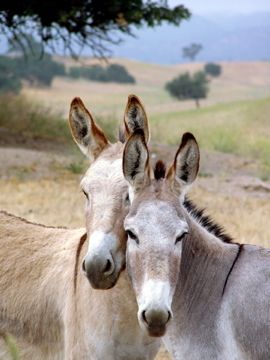What happens to neglected, abandoned or abused horses in San Luis Obispo County? Who takes over their care? How do they become adoptable horses? What steps are taken to rehome these horses?
Recently, another batch of neglected and abandoned horses came into the care of SLO County Animal Services. Animal Services does a fantastic job removing dogs, cats, horses, and other animals from abusive situations. For larger animals, like horses, animal services agencies have limited funding. In addition, staff expertise is limited to only providing essential care: feed, water, shelter and safety plus vet and hoof treatment for the horses they seize due to neglect, abandonment or abuse. Therefore, SLO County Animal Services called Redwings Horse Rescue and Sanctuary to help them develop a plan of action for the seized horses’ assessment and care. They want to give these horses the best chance of being adopted.
Partnering with Animal Services When Horses are Seized
Here in SLO County a group of 34 horses, one of the largest seizures in decades, were seized through SLO County Animal Services. “We stepped in and took three of the horses right away,” said Sara Ruggerone, Equine Care Manager of Redwings Horse Rescue and Sanctuary currently located in Lockwood, CA but soon to be relocating to Paso Robles. “We also helped Animal Services take photos and catalog, vaccinate, microchip and deworm the horses.” Sara often donates her time to help process groups of incoming horses to Animal Services. She was on hand for this large case and looks forward to partnering with them in the future.

Developing Adoptable Horses
One of the key elements to rehoming a horse is its serviceability. An adoptable horse at the bare minimum needs to accept a halter, lead, pick up its feet, brushed and bathed. It needs to be comfortable in a stall or paddock. Getting a horse accustomed to these activities takes time and skill. Animal Services really has limited resources for turning seized horses into adoptable horses, and there is a need for skilled volunteers.
Redwings Makes a Plan for Each Horse

Redwings Horse sanctuary location houses 70-90 horses at any one time and fills a critical gap in services by accepting the worst cases of abuse and bringing those horses back to health. “Our care is tailored to each individual horse,” Sara explains. “We evaluate the health concerns, how a horse has been treated; we determine how a horse is doing physically and emotionally.” Once a plan is in place the rehab process begins. Veterinarians treat health issues and some horses go out to trainers for work. As a non-profit organization, Redwings Horse Sanctuary covers this costly rehab and ongoing care thanks to the generosity of their donors.

Redwings Rehabs Rescue Horses
The rehab process can take months, or weeks. It really depends on the horse. “We also look down the road and consider what the horse could be used for,” described Sara. “A horse’s age, breed and level of training is measured and we determine if the horse could be a riding horse or a companion animal.” The hope for every horse is to develop into a well-adjusted riding partner or companion horse. However, horses who are not adoptable due to age, injury or illness have a permanent home in the sanctuary.
Redwings is now preparing to take on three more of the seized horses from Animal Services.

Rehoming Rescue Horses
One great way to make adopting a horse easier is through the Redwings Foster to Adopt program. This program connects potential horse owners to horse care slowly. To become a foster home, potential horse foster care homes fill out an application. Then a mandatory home inspection is conducted before a home is approved for a horse placement. During the one-year foster care period, Redwings staff are involved in helping facilitate a happy placement for both the horse and foster home. At the end of the year time-period the foster family can formally adopt the horse.
How Does Redwings Pay for Developing Adoptable Horses?

Horses in the care of Animal Services are funded through taxpayer’s dollars. In contrast, all of Redwing’s operational support comes from individual and foundation support. These are people who believe in and invest in their mission to rescue abused and neglected equines.
Redwings is very grateful for all donations. Their daily operations rely on the generosity of loyal monthly donors, along with the Thoroughbred Aftercare Alliance, the California Retirement Management Account (CARMA), and the Mary Jo and Hank Greenberg Animal Welfare Foundation for their support.
How Can Our Local Horse Community Help Turn Seized Horses into Adoptable Horses?
- Experienced equestrians can play a part in helping develop adoptable horses. Animal Services could use your help in expanding their work by taking the time to get a horse comfortable with a halter, leading, grooming, bathing and picking up its feet.
- Help get good pictures of cleaned up horses up on the Animal Service website. Even better would be pictures of the horses under saddle.
- Spread the word. Pass on any info regarding adoptable horses through your social media contacts.
- Consider being a foster home for a horse in transition while you provide the basic training to develop it into an adoptable horse. You may end up being its forever home.
- Contact your congressman or local representatives in SLO and Monterey Counties to press for harsher punishments for animal abusers.
- Adopt, don’t shop! Demand in our community to provide a safe home for at-risk and retired horses far outweighs the resources of sanctuaries like Redwings and animal services agencies. Adoption helps give a horse a second chance. It also opens up space for another rescued horse. Consider adopting your next horse or companion animal.
For more information on being a part of developing horses in transition into adoptable horses check out the Right Horse Initiative. To help local horses become adoptable horses contact Dr. Anderson at SLO Animal Services or Redwings Horse Rescue and Sanctuary.




